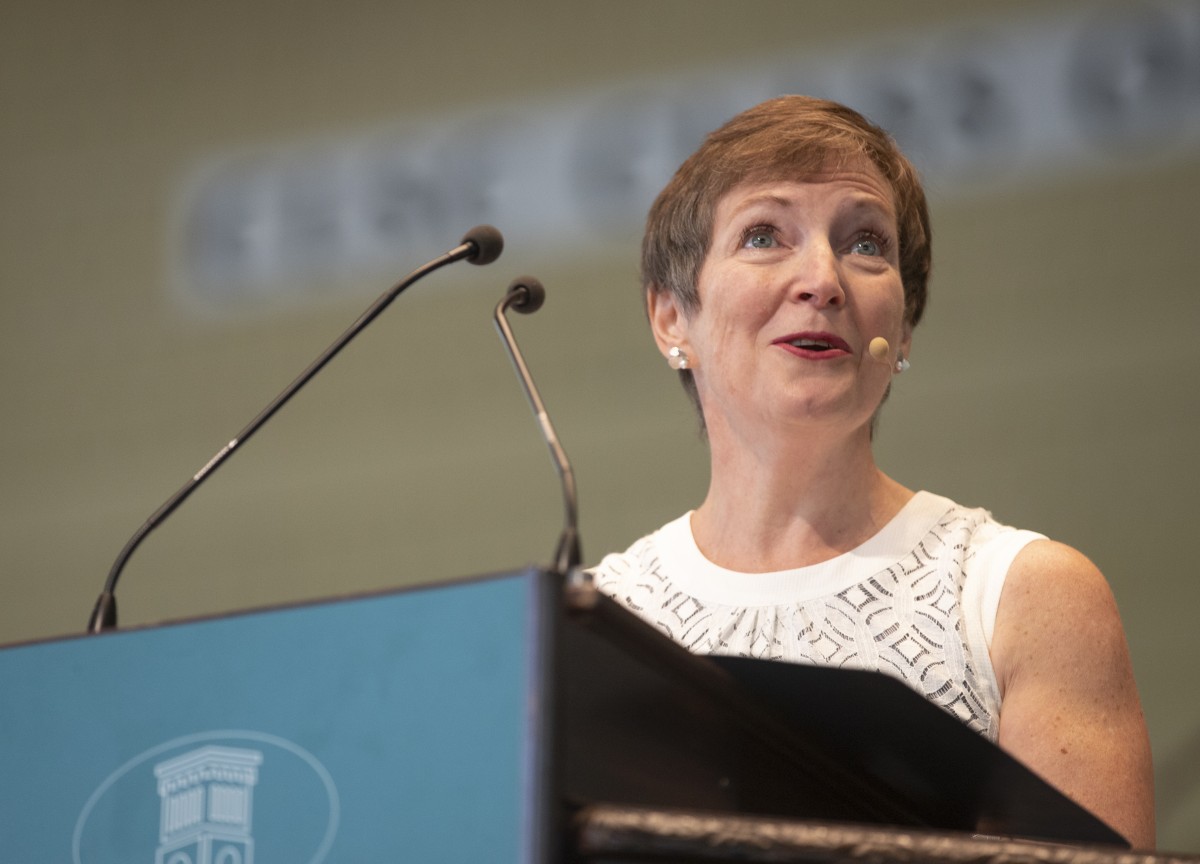
It’s time to be gender bilingual — not gender blind.
A chief executive officer, author and proponent for “gender bilingual” business management, Avivah Wittenberg-Cox spoke to gender balance in the workplace, continuing Week Six’s theme, “The Changing Nature of Work” — a relief, she said, from previous difficult themes like “Russia and the West” or “The Ethics of Dissent.”
“What I want to offer will be much, much simpler,” she joked. “You can relax, put down your fears, your defenses, your anger; I’m only going to be talking about men and women.”
Her 10:45 a.m. morning lecture Wednesday, Aug. 1, came at a relevant moment for Chautauqua Institution, as this season’s morning lecture platform is gender balanced, with 25 women and 27 male lecturers, Wittenberg-Cox said.
She opened her lecture by polling the Amphitheater audience. She asked how many people thought there were differences between men and women; the majority of attendees raised their hands. She then turned to the men and asked who thought they understood women; less than five hands crept up. Finally, she turned to the women and asked who thought they understood men; significantly more hands shot up, accompanied by soft chuckles.
These opinions are not exclusive to the Amp audience.
“Most of the business leaders I work with every day proudly claim that they treat men and women exactly the same…. They are convinced of it. They say, and repeat proudly, they see themselves as progressive, that they are ‘gender blind.’ It’s one of our biggest obstacles because treating people equitably isn’t actually the same as treating them identically.”
-Avivah Wittenberg-Cox ,CEO, 20-first
As CEO of 20- first, Wittenberg-Cox works with corporate executives to identify and achieve opportunities for gender balance in business, as well as serving as a coach for CEOs and senior-level executives.
Behind closed doors, men admit to not understanding women — and “How are they supposed to? Where would they have learned?” Wittenberg-Cox argued. The men in top-tier positions, she said, have spent most of their careers in male-dominated systems, isolated from conversations about “the secondary sex.”
This isolationism stems from the dominant 20th-century workplace model, characterized by people in factories as mechanisms for capitalism — a model designed by men, for men, she said, which worked well (for select people) until four “W’s” disrupted this ecosystem: web, weather, world and women.
“This last ‘W,’ women, is not usually put on a par with the other three,” Wittenberg-Cox said. “And yet I would suggest it’s had a huge impact on the life of every man, woman and child on the planet. They have all been affected by the changing roles of women.”
Although historians rarely frame women as revolutionaries, she said, the statistics are telling.
Over half of university graduates worldwide are women. In the United States, 58 percent of bachelor’s degrees are earned by women, 63 percent in Brazil, 60 percent in Iran and 70 percent in the United Arab Emirates.
Gender-balanced companies have 53 percent higher returns than male-dominated companies, Wittenberg-Cox said, and if America’s female labor participation growth paralleled Japan’s, the national gross domestic product would increase by 4 percent.
Instead, she said, the United States is the only “rich country” where the female labor force population has declined. Studies, Wittenberg-Cox said, indicate a $30 trillion income transfer to women through inheritances — making the purchasing power of U.S. women likely to exceed China and India’s combined GDP.
“Women today represent most of the talent and much of the market. So why do you think we call (gender balance) a women’s issue or, my most unfavorite term, a diversity issue?” Wittenberg-Cox said. “Why did we ever accept the term ‘diversity’ to describe a mix of men and women? As soon as you put women under the umbrella of diversity, it’s been a very effective way of keeping women what they’re not — a minority to be banished among many. For most companies I work with, this gender issue is a pressing business imperative.”
A company in 2018 looks vastly different from companies of the industrial boom of the 20th century. At the bottom of the corporate ladder, men and women are represented equally, she said, but as you climb, the disparity widens. It is not a “glass ceiling,” Wittenberg-Cox stressed, where barriers cap women at salaries or ranks — instead, it’s a “gender asbestos,” where women are dissolved off the corporate ladder over time.
The common misconception is that this gap is a personal choice, that women’s desire to have children contributes to the gender gap — as if men don’t have children — or that a lack of confidence causes women not to apply for promotions, Wittenberg-Cox said. The common solution is to build women’s networks, implement leadership training and create coaching for professional women.
“Almost every corporation in America has been doing this for decades now,” she said. “The result hasn’t been gender balance. The result has been gender fatigue … and a sense, especially for leaders, ‘that we’ve tried everything, nothing works. They just don’t want it.’ Or, alternatively, ‘gender is done, we’ve got to move on to other things.’ What I’d suggest is we haven’t actually started the real work of gender balance yet.”
So what’s next? According to Wittenberg-Cox, it’s a reframing of gender balance, away from “women’s networks” to a business opportunity for increased corporate performance by tapping into a talented pool of women and a sea of consumers.
Wittenberg-Cox emphasized that pushing women into top-tier leadership roles to promote gender balance doesn’t work. Instead, people are more receptive to a credible person who looks like themselves, and in a male-dominated market, that person is male.
Men need education rather than accusations, she said, and 20- first strives to build executives’ confidence in gender balance and managing gender issues.
Aside from gender-bilingual workplace management, Wittenberg-Cox highlighted gender balance at home.
“We discover, sometimes late, that one of the most important career choices we make is the spouse we marry,” she said. “This is true for men, but I’d suggest it’s even truer still for women. … Ambitious career women really only have two choices: either you have a super-supportive spouse, or none — because anything in between is a career, morale-sapping mess.”
Dual careers are becoming the norm in partnerships, unlike old domestic practices, Wittenberg-Cox said. Simultaneously, sharing of the parenting years is becoming the norm.
So while three generations ago, women were fighting for the ballot, and since then generations have seen the invention of birth control and onset of well-paying jobs for women, she said, the next generation of women will likely witness a major milestone toward equal parental leave.
“This has never been a battle between men and women. It’s a battle between progressives and the rest,” Wittenberg-Cox said. “We need men on the stage and every other stage arguing for gender balance. We need to get men convincing other men. … I’m talking to enlightened self-interest. Gender balance is good for everyone … It’s not ‘he for she,’ it’s ‘he for he.’ Don’t do it for us.Do it for your shareholders, your customers, your kids.”
Gender balance strengthens “the three C’s,” Wittenberg-Cox said; it makes countries more competitive, companies more profitable and couples more resilient.
“And if we get it right,” she said, “we will succeed in a fourth ‘C,’ … civilization.”
After the conclusion of Wittenberg-Cox’s lecture, Emily Morris, vice president of marketing and communications and chief brand officer, opened the Q-and-A by asking for examples of organizations that have increased diversity by achieving gender balance.
“Actually, I don’t think I did argue that gender balance builds diversity,” Wittenberg-Cox said. “I would argue, and have argued, … that gender balance builds performance, builds talent acquisition, builds customer connections. It builds what companies say they will and want to do better.”
Morris then turned to the audience for questions; attendees asked for Wittenberg-Cox’s thoughts on issues like #MeToo and challenges facing stay-at- home dads. To close the Q-and-A, Wittenberg-Cox was asked for her thoughts on a Supreme Court ruling, which, an attendee said, ruled that women could not sue as a class against Walmart for unequal pay.
“This is what women’s networks are for, this is where #MeToo was so successful,” Wittenberg-Cox said. “… Outside of companies and across certain sectors, this is where coalitions of women have a huge amount of bearing, and if we can’t have class action suits, we can certainly hit (companies) reputationally, which is what #MeToo has done. If you can’t get them through the courts, get them through social media.”





